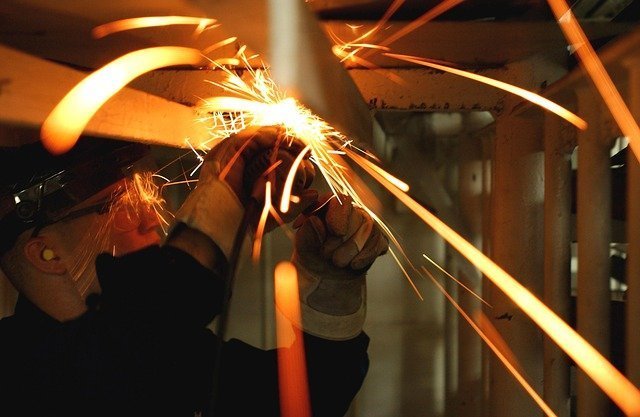Measure Twice, Cut Once!
Most container modification plans involve adding windows, doors, ventilation ducts, or even opening a sidewall. Cutting openings in Cor-Ten steel containers, though not as simple as cutting wood, can be achieved with a variety of different tools you may have available in your workshop. The first and most important thing is to protect yourself while working with cutting tools.
Regardless of the tool you use, the cut steel will have very sharp edges; use a pair of thick leather gloves like the ones used for welding. The cutting process will involve sparks and metal chips, so use eye protection!
The tools are noisy, and the steel shipping container will amplify the noise, so use good ear protection!
Also, wear a long-sleeved shirt and long pants. I know it may not always be comfortable, but it’s certainly better than having hot metal chips falling on you.
How to Cut Openings in Containers?
Containers are built with 12-gauge steel, approximately 1/8 inch thick. To begin, use a sharpie marker to clearly mark your opening on the container’s steel. If cutting openings in containers is not or will not become a common practice for you, you can use a general saw or a reciprocating saw with a heavy-duty steel blade.
Save yourself some hassle here, don’t buy cheap blades; they are cheap for a reason. This is heavy-duty work, and you need a durable blade that will last and not break.
Drill a hole inside the line of your marked opening large enough for your saw blade, insert the blade, and start cutting along the line. You can also use a skill saw with a good metal-cutting blade.
To start cutting openings in containers, first place your blade on your mark to align it. Lift the back of the skill saw enough for the blade to come out of the container’s surface and start spinning the saw blade. Slowly, lower the skill saw blade onto the mark until it cuts through the metal, and then continue cutting along your line. You will need to repeat this process when you reach the corners, as a skill saw does not rotate.
Don’t panic if you deviate a bit from the line with any of these cutting methods; any mistakes can be easily corrected. Those who cut this type of steel more regularly will have a torch available, or the ultimate cutting tool, a plasma cutter, in their arsenal of tools. These will be much faster and easier than saws and much less tricky when bending corners.
You can rent them at most equipment rental places, but practice with some scrap before you start cutting on your container. Although it is heavy-duty work, cutting openings in containers is not difficult and can be done with any number of tools.
How to Cut Openings in Containers: Tips and Important Considerations
Cutting openings in Cor-Ten steel containers is an exciting process, but it requires attention and proper precautions to ensure a safe and efficient job. Before starting the cut, here are some tips and important considerations to further enrich the process:
- Planning and Precise Measurement: Before picking up any cutting tool, take time for planning. Consider the size and location of the required openings and clearly mark the cut lines accurately. Use a level to ensure that your markings are straight, especially if you’re cutting more than one opening.
- Appropriate Tools: Choosing the right tools makes all the difference. In addition to a general saw or reciprocating saw, consider investing in a plasma cutter or a torch for more frequent tasks. These tools are more efficient and produce cleaner cuts, saving you time and effort.
- Safety First: When cutting any type of metal, safety is essential. Always wear protective gear, such as safety glasses, sturdy leather gloves, ear protectors, and suitable long-sleeved shirts and pants. Remember that the cut steel can be sharp, and sparks can be dangerous, so keep your workspace organized and free from flammable objects.
- Practice with Scrap: If you’re new to metal cutting or using a new tool, it’s advisable to practice on scrap before starting the main project. This will allow you to familiarize yourself with the tool and adjust your technique, ensuring more precise cuts on the actual container.
- Protection Against Rust: When cutting Cor-Ten steel, the outer layer of iron oxide provides protection against rust. It’s crucial to protect the cut edges to prevent excessive rust formation. Apply a rust-resistant sealant to the cut areas after the cutting work to preserve the container’s structural integrity.
- Creative Reuse: When modifying containers, consider reusing the cut parts in other projects. Cor-Ten steel pieces can be transformed into decorative elements, shelves, or supports, adding a unique and sustainable touch to your creation.
Always remember that safety is the number one priority when performing any cutting work, and following proper guidelines will ensure you achieve the best results. With care and skill, cutting openings in containers can open up a world of creative and functional possibilities for you to explore!




